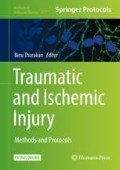Abstract
Vascular hyperpermeability is one of the known detrimental effects of hemorrhagic shock, which we continually try to understand, minimize, and reverse. Here, we describe induction of hemorrhagic shock in a rat and studying of its effects on vascular permeability, using intravital microscopy. In this protocol, hemorrhagic shock will be induced by withdrawing blood to reduce the mean arterial pressure (MAP) to 40 mmHg for 60 min followed by resuscitation for 60 min. To study the changes in vascular permeability following hemorrhagic shock, the rats will be given FITC-albumin, a fluorescent tracer, intravenously. Following this, the FITC-albumin flux across the vessel will be measured in mesenteric postcapillary venules by determining fluorescent intensity intravascularly and extravascularly under intravital microscopy.
Access this chapter
Tax calculation will be finalised at checkout
Purchases are for personal use only
References
Childs E et al (1999) Leukocyte adherence and sequestration following hemorrhagic shock and total ischemia in rats. Shock 11:248–252
Childs EW, Udobi KF, Wood JG, Hunter FA, Smalley DM, Cheung LY (2002) In vivo visualization of reactive oxidants and leukocyte-endothelial adherence following hemorrhagic shock. Shock 8:423–427
Tharakan B et al (2010) (−)-Deprenyl inhibits vascular hyperpermeability after hemorrhagic shock. Shock 33:56–63
Childs E et al (2007) Apoptotic signaling induces hyperpermeability following hemorrhagic shock. Am J Physiol Heart Circ Physiol 292:H3179–H3189
Childs E et al (2010) 17β-estradiol mediated protection against vascular leak after hemorrhagic shock: role of estrogen receptors and apoptotic signaling. Shock 34:229–235
Murao Y, Hata M, Ohnishi K, Okuchi K, Nakajima Y, Hiasa Y, Junger WG, Hoyt DB, Ohnishi T (2003) Hypertonic saline resuscitation reduces apoptosis and tissue damage of the small intestine in a mouse model of hemorrhagic shock. Shock 20:23–28
Childs EW, Udobi KF, Hunter FA, Dhevan V (2005) Evidence of transcellular albumin transport after hemorrhagic shock. Shock 23:565–570
Davidson MT, Deitch EA, Lu Q, Hasko G, Abungu B, Nemeth ZH, Zaets SB, Gaspers LD, Thomas AP, DZ X (2004) Trauma-hemorrhagic shock mesenteric lymph induces endothelial apoptosis that involves both caspase-dependent and caspase-independent mechanisms. Ann Surg 240:123–131
Therade-Matharan S, Laemmel E, Duranteau J, Vicaut E (2004) Reoxygenation after hypoxia and glucose depletion causes reactive oxygen species production by mitochondria in HUVEC. Am J Physiol Regul Integr Comp Physiol 287:R1037–R1043
Savoye G, Tamion F, Richard V, Varin R, Thuillez C (2005) Hemorrhagic shock resuscitation affects early and selective mesenteric artery endothelial function through a free radical-dependent mechanism. Shock 23:411–416
Author information
Authors and Affiliations
Corresponding author
Editor information
Editors and Affiliations
Rights and permissions
Copyright information
© 2018 Springer Science+Business Media, LLC
About this protocol
Cite this protocol
Esiobu, P., Childs, E.W. (2018). A Rat Model of Hemorrhagic Shock for Studying Vascular Hyperpermeability. In: Tharakan, B. (eds) Traumatic and Ischemic Injury. Methods in Molecular Biology, vol 1717. Humana Press, New York, NY. https://doi.org/10.1007/978-1-4939-7526-6_5
Download citation
DOI: https://doi.org/10.1007/978-1-4939-7526-6_5
Published:
Publisher Name: Humana Press, New York, NY
Print ISBN: 978-1-4939-7524-2
Online ISBN: 978-1-4939-7526-6
eBook Packages: Springer Protocols

